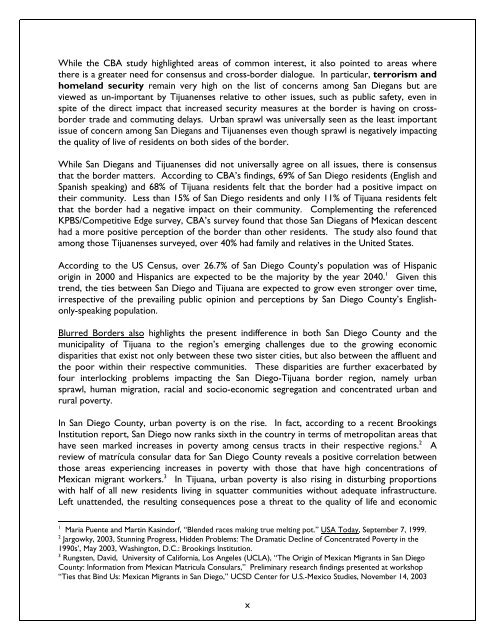Blurred Borders - International Community Foundation
Blurred Borders - International Community Foundation
Blurred Borders - International Community Foundation
Create successful ePaper yourself
Turn your PDF publications into a flip-book with our unique Google optimized e-Paper software.
While the CBA study highlighted areas of common interest, it also pointed to areas where<br />
there is a greater need for consensus and cross-border dialogue. In particular, terrorism and<br />
homeland security remain very high on the list of concerns among San Diegans but are<br />
viewed as un-important by Tijuanenses relative to other issues, such as public safety, even in<br />
spite of the direct impact that increased security measures at the border is having on crossborder<br />
trade and commuting delays. Urban sprawl was universally seen as the least important<br />
issue of concern among San Diegans and Tijuanenses even though sprawl is negatively impacting<br />
the quality of live of residents on both sides of the border.<br />
While San Diegans and Tijuanenses did not universally agree on all issues, there is consensus<br />
that the border matters. According to CBA’s findings, 69% of San Diego residents (English and<br />
Spanish speaking) and 68% of Tijuana residents felt that the border had a positive impact on<br />
their community. Less than 15% of San Diego residents and only 11% of Tijuana residents felt<br />
that the border had a negative impact on their community. Complementing the referenced<br />
KPBS/Competitive Edge survey, CBA’s survey found that those San Diegans of Mexican descent<br />
had a more positive perception of the border than other residents. The study also found that<br />
among those Tijuanenses surveyed, over 40% had family and relatives in the United States.<br />
According to the US Census, over 26.7% of San Diego County’s population was of Hispanic<br />
origin in 2000 and Hispanics are expected to be the majority by the year 2040. 1 Given this<br />
trend, the ties between San Diego and Tijuana are expected to grow even stronger over time,<br />
irrespective of the prevailing public opinion and perceptions by San Diego County’s Englishonly-speaking<br />
population.<br />
<strong>Blurred</strong> <strong>Borders</strong> also highlights the present indifference in both San Diego County and the<br />
municipality of Tijuana to the region’s emerging challenges due to the growing economic<br />
disparities that exist not only between these two sister cities, but also between the affluent and<br />
the poor within their respective communities. These disparities are further exacerbated by<br />
four interlocking problems impacting the San Diego-Tijuana border region, namely urban<br />
sprawl, human migration, racial and socio-economic segregation and concentrated urban and<br />
rural poverty.<br />
In San Diego County, urban poverty is on the rise. In fact, according to a recent Brookings<br />
Institution report, San Diego now ranks sixth in the country in terms of metropolitan areas that<br />
have seen marked increases in poverty among census tracts in their respective regions. 2 A<br />
review of matrícula consular data for San Diego County reveals a positive correlation between<br />
those areas experiencing increases in poverty with those that have high concentrations of<br />
Mexican migrant workers. 3 In Tijuana, urban poverty is also rising in disturbing proportions<br />
with half of all new residents living in squatter communities without adequate infrastructure.<br />
Left unattended, the resulting consequences pose a threat to the quality of life and economic<br />
1 Maria Puente and Martin Kasindorf, “Blended races making true melting pot.” USA Today, September 7, 1999.<br />
2 Jargowky, 2003, Stunning Progress, Hidden Problems: The Dramatic Decline of Concentrated Poverty in the<br />
1990s’, May 2003, Washington, D.C.: Brookings Institution.<br />
3 Rungsten, David, University of California, Los Angeles (UCLA), “The Origin of Mexican Migrants in San Diego<br />
County: Information from Mexican Matricula Consulars,” Preliminary research findings presented at workshop<br />
“Ties that Bind Us: Mexican Migrants in San Diego,” UCSD Center for U.S.-Mexico Studies, November 14, 2003<br />
x















